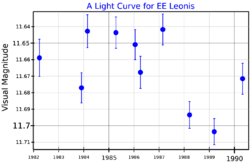Astronomy:Gliese 402
| Observation data Equinox J2000.0]] (ICRS) | |
|---|---|
| Constellation | Leo |
| Right ascension | 10h 50m 52.03129s[2] |
| Declination | +06° 48′ 29.2278″[2] |
| Apparent magnitude (V) | 11.64 - 11.70[3] |
| Characteristics | |
| Spectral type | M4.0V[4] |
| U−B color index | +1.16[5] |
| B−V color index | +1.66[5] |
| V−R color index | +1.24[5] |
| R−I color index | +1.57[5] |
| Variable type | BY Dra[3] |
| Astrometry | |
| Radial velocity (Rv) | -1.04[6] km/s |
| Proper motion (μ) | RA: −856.185[7] mas/yr Dec.: −818.607[7] mas/yr |
| Parallax (π) | 143.5391 ± 0.0286[8] mas |
| Distance | 22.722 ± 0.005 ly (6.967 ± 0.001 pc) |
| Absolute magnitude (MV) | 12.47[5] |
| Details | |
| Mass | 0.255 ± 0.014[9] M☉ |
| Radius | 0.3[10] R☉ |
| Surface gravity (log g) | 4.5[11] cgs |
| Temperature | 3100[11] K |
| Metallicity [Fe/H] | -0.06[9] dex |
| Other designations | |
| Database references | |
| SIMBAD | data |
| ARICNS | data |
Gliese 402 is a star located 22.7 light years from the Solar System. Located in the constellation of Leo, it is also known as Wolf 358 from its entry in Max Wolf's star catalogue. The stars nearest to Gliese 402 are Gliese 393, at 3.43 light years, Gliese 408, at 6.26 light years, and Gliese 382 at 6.66 light years.[12]
Gliese 402 is a BY Draconis variable, with its apparent magnitude varying between 11.64 and 11.70. The brightness changes are due to starspots and chromospheric activity combined with the rotation of the star. It has been given the variable star designation EE Leonis.[3]
Like the vast majority of stars in the Solar neighborhood, Gliese 402 is a dim red dwarf. With an apparent magnitude +11.66, it is far too dim to be seen with the naked eye; it can only be seen with a telescope. Its luminosity is only 0.091% that of the Sun.[12] Its spectral type is M4V (sometimes cited as M5V[citation needed]) and its effective temperature is about 3100 K. Its physical characteristics are quite similar to those of Ross 128 or Kruger 60 B, with a radius of about 30% of the Sun.[10] Its projected rotation speed is at most 2.3 km/s or less,[9] while its metallicity is slightly lower than that of the Sun.[9]
References
- ↑ Weis, Edward W. (March 1994). "Long Term Variability in Dwarf M Stars". The Astronomical Journal 107 (3): 1135–1140. doi:10.1086/116925. Bibcode: 1994AJ....107.1135W. https://ui.adsabs.harvard.edu/abs/1994AJ....107.1135W. Retrieved 19 January 2022.
- ↑ 2.0 2.1 van Leeuwen, F. (2007). "Validation of the new Hipparcos reduction". Astronomy and Astrophysics 474 (2): 653–664. doi:10.1051/0004-6361:20078357. Bibcode: 2007A&A...474..653V. http://www.aanda.org/index.php?option=com_article&access=bibcode&Itemid=129&bibcode=2007A%2526A...474..653VFUL.
- ↑ 3.0 3.1 3.2 Samus, N. N. et al. (2009). "VizieR Online Data Catalog: General Catalogue of Variable Stars (Samus+ 2007-2013)". VizieR On-line Data Catalog: B/GCVS. Originally Published in: 2009yCat....102025S 1. Bibcode: 2009yCat....102025S.
- ↑ Alonso-Floriano, F. J.; Morales, J. C.; Caballero, J. A.; Montes, D.; Klutsch, A.; Mundt, R.; Cortés-Contreras, M.; Ribas, I. et al. (2015). "CARMENES input catalogue of M dwarfs". Astronomy & Astrophysics 577: A128. doi:10.1051/0004-6361/201525803. Bibcode: 2015A&A...577A.128A. http://goedoc.uni-goettingen.de/goescholar/bitstream/handle/1/12402/aa25803-15.pdf.[yes|permanent dead link|dead link}}]
- ↑ 5.0 5.1 5.2 5.3 5.4 "ARICNS 4C00824". ARICNS. http://wwwadd.zah.uni-heidelberg.de/datenbanken/aricns/cnspages/4c00824.htm. Retrieved 23 January 2017.
- ↑ Nidever, David L. (2013). "Radial Velocities for 889 Late-Type Stars". The Astrophysical Journal Supplement Series 141 (2): 503–522. doi:10.1086/340570. Bibcode: 2002ApJS..141..503N.
- ↑ 7.0 7.1 Brown, A. G. A; Vallenari, A; Prusti, T; De Bruijne, J. H.J; Mignard, F; Drimmel, R; Babusiaux, C; Bailer-Jones, C. A.L et al. (2016). "Gaia Data Release 1". Astronomy & Astrophysics 595: A2. doi:10.1051/0004-6361/201629512. Bibcode: 2016A&A...595A...2G.
- ↑ Brown, A. G. A. (2021). "Gaia Early Data Release 3: Summary of the contents and survey properties". Astronomy & Astrophysics 649: A1. doi:10.1051/0004-6361/202039657. Bibcode: 2021A&A...649A...1G. Gaia EDR3 record for this source at VizieR.
- ↑ 9.0 9.1 9.2 9.3 Jenkins, J. S.; Ramsey, L. W.; Jones, H. R. A.; Pavlenko, Y.; Gallardo, J.; Barnes, J. R.; Pinfield, D. J. (2009). "Rotational Velocities for M Dwarfs". The Astrophysical Journal 704 (2): 975–988. doi:10.1088/0004-637X/704/2/975. Bibcode: 2009ApJ...704..975J.
- ↑ 10.0 10.1 Pasinetti Fracassini, L. E. et al. (2001). "Catalogue of Apparent Diameters and Absolute Radii of Stars (CADARS) - Third edition - Comments and statistics". Astronomy & Astrophysics 367 (2): 521–24. doi:10.1051/0004-6361:20000451. Bibcode: 2001A&A...367..521P.
- ↑ 11.0 11.1 Lépine, Sébastien (2013). "A Spectroscopic Catalog of the Brightest (J < 9) M Dwarfs in the Northern Sky". The Astronomical Journal 145 (4): 102. doi:10.1088/0004-6256/145/4/102. Bibcode: 2013AJ....145..102L.
- ↑ 12.0 12.1 "Stars within 15 light-years of Wolf 358". The Internet Stellar Database. http://www.stellar-database.com/Scripts/find_neighbors.exe?ID=72600&ly=15.
 |


